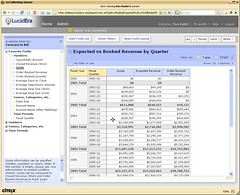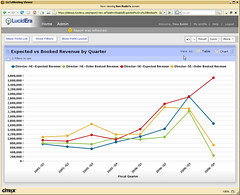Last in the morning’s general session was Tom Laffey, TIBCO’s EVP of products and technologies, and Matt Quinn, VP of product management and strategy. Like Ranadivé’s talk earlier, they’re talking about enterprise virtualization: positioning messaging, for example, as virtualizing the network layer, and BPM as enterprise process virtualization. I’m not completely clear if virtualization is just the current analyst-created buzzword in this context.
Laffey and Quinn tag-teamed quite a bit during the talk, so I won’t attribute specific comments to either. TIBCO products cover a much broader spectrum that I do, so I’ll focus just on the comments about BPM and SOA.
TIBCO’s been doing messaging and ESB for a long time, and some amount of the SOA talk is about incremental feature improvements such as easier use of adapters. Apparently, Quinn made a prediction some months ago that SOA would grow so fast that it would swallow up BPM, so that BPM would just be a subset of SOA. Now, he believes (and most of us from the BPM side agree 🙂 ) that BPM and SOA are separate but extremely synergistic practices/technologies, and both need to developed to a position of strength. To quote Ismael Ghalimi, BPM is SOA’s killer application, and SOA is BPM’s enabling infrastructure, a phrase that I’ve included in my presentation later today; like Ismael, I see BPM as a key consumer of what’s produced via SOA, but they’re not the same thing.
They touched on the new release of Business Studio, with its support for BPMN, XPDL and BPEL as well as UML for some types of data modelling. There’s some new intelligent workforce management features, and some advanced user interface creation functionality using intelligent forms, which I think ties in with their General Interface AJAX toolkit.
Laffey just defined “mashup” as a browser-based event bus, which is an interesting viewpoint, and likely one that resonates better with this audience than the trendier descriptions.
They discussed other functionality, including business rules management, dynamic virtual information spaces (the ability to tap into a real-time event message stream and extract just what you want), and the analytics that will be added with the acquisition of Spotfire. By the way, we now appear to be calling analytics “business insight”, which lets us keep the old BI acronym without the stigma of the business intelligence latency legacy. 🙂
They finished up with a 2-year roadmap of product releases, which I won’t reproduce here because I’d hate to have to embarrass them later, and some discussion of changes to their engineering and product development processes.


